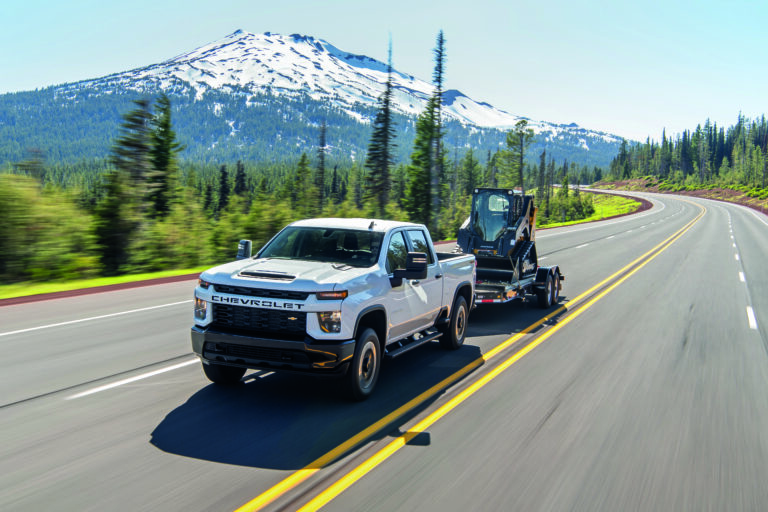Back in March 2018, GM announced a bold and daring ‘zero, zero, zero’ strategic future plan. “We have the ambition, the talent and the technology to create a world with zero crashes, zero emissions and zero congestion,” said GM chairman and CEO Mary Barra back then. And focusing on the middle part of Barra’s stirring vision – emissions output – GM has created a new advanced modular global EV platform with proprietary Ultium battery technology that’s all set for implementation.
Things start with the General’s luxury car brand, Cadillac, which plans to sell an all-electric Lyriq SUV and from there eventually transition to being either nearly – or completely – an all-EV brand by 2030. The market will also see a new second-generation Chevrolet Bolt and the Hummer moniker revived in the form of an upcoming GMC EV. But that BEV push doesn’t mean IC engine development is dead for Detroit’s largest car manufacturer. Far from it, in fact, as Jeff Luke, executive director of global gasoline engines outlines.
“People like to ask, ‘When will this all-EV transition happen?’,” says Luke. “But things won’t change overnight. My personal opinion is that it’s not only a matter of when but also where – there’s a geographical element to it. When you look around the world, there’s a lot of focus on EV in certain areas – parts of the USA and Canada, for instance. And there’s a big push for electrification in China. But there are also places in the world with no such plans.”
As a result, it’s clear to Luke that the internal combustion engine definitely has a positive future, at least within GM circles. “You can be really good in both areas [BEV and ICE]. We really want to be really good in ICE – continuing to evolve that design, efficiency and technology.”
One of the most emotive discussion points for engine enthusiasts across the USA is the turbocharging versus naturally aspirated debate, with most falling into one or the other category for engine preference.
Over at Ford, nearly all of the company’s engines carry a turbocharger. While GM is certainly offering engines in that forced induction arena, the company isn’t as heavy on ‘charging’. “We want to make sure our customers have the right technology for the right application,” says Luke.
“There’s always a lot of debate and conjecture. Ford has its strategy. We also have a number of turbocharged engines. We have our three-cylinder engine in our smaller SUVs and the 1-liter and 1.2-liter turbos in South America. And there’s the 2.7-liter turbo in our full-size pickup – we’re very proud of that one.”
And as for atmo engine designs? “In our truck line-up, for heavier usage customers – so the likes of heavier payload and towing needs – we like an NA engine. Ford offers its 2.7-liter and 3.5-liter EcoBoost. But they also still offer an NA V8 in their line-up. There are pros and cons to turbo versus NA. There are customers who comment on real-world fuel economy when trailering with twin-turbos, for instance. They don’t necessarily see the fuel economy they expect. With naturally aspirated, it’s more efficient with notably higher loads.”
Luke insists atmo development has a future within General Motors: “We continue to work on technologies that will change CO2 output – improve it, meet standards and such like – but also improve the real-world fuel economy. With the work we’re doing in the combustion space – so fuel and fuel pressure to name just two aspects – we have a good line-of-sight on how to do all of that in both NA and turbo applications.”
And of course, there’s also supercharging technology, which is traditionally found in performance vehicle applications at GM. “I think that’s predominantly where you’ll keep seeing supercharger technology – in those performance applications,” adds Luke.

“When you think about ‘charging’ in general, there’s supercharging and turbocharging technologies. And there are different types of turbocharging – so single scroll, dual scroll, VGT and so on. There’s really a lot of work going on in that area. And there’s also e-chargers. We’re watching that very closely too. You see a lot of suppliers looking at their tech road future and looking at e-charger development. I foresee positive benefits but you have to make sure you have the right application.”
Directly related to performance vehicles at GM is motorsports. “Racing is very important to us,” reiterates Luke. “The engine racing team works directly in my group. We have a lot of stuff going on there. There’s the Corvette C8.R and a new engine to go with it, which my team is responsible for. There’s also IndyCar, NASCAR, IMSA, COPO Camaro and the GT4.R Camaro GT4 series. We also do all the performance parts and crate engines.”
“I very much see the advantages of the trickle down of technology to road cars from motorsport. The race program is always in discussion with the production engine team – they’re always talking and comparing notes. And a good example of that is with Corvette development.”
Luke and his team must also confront the engineering and technical challenges of global emissions standards. “The North American market is pretty straightforward,” responds Luke without hesitation. “You’re asked whether to be BIN 125 or BIN 70 or BIN 30. With the technology we have, we have no troubles there.”
And it’s quite clear that’s the ‘easy’ part for GM. “It’s more the challenges globally with global architectures when you’re trying to use the same drivetrain in multiple markets,” adds Luke. “In China, for instance, we have to use gasoline particulate filters. You end up having a different hardware solution and, of course, different software controls and calibration solutions on that engine. It’s really the everyday challenge of managing complexity. You need to have a range of different design solutions.
“We’re constantly asking what’s the best thing to do. Say, with catalytic converters – how do we make sure we have a line-up that meets the market requirements? You’re trying to make sure you can manage that complexity so it’s not out of control. We don’t have infinite design, calibration and validation resources.”
There’s also small displacement engines and traditionally less emissions-stringent markets such as South America to take into consideration. “Our new vehicles with the 1.0 and 1.2 three-cylinder engines are selling like hotcakes,” Luke says proudly. “People in South America appreciate the integration and performance of those engines. We continue to watch the regulatory environment down there. South America – Brazil, specifically – is PL6 [Proconve L6] and is now going to PL7. And there’s talk of Rota 2030 [both for safety and emissions aspects]. So we are constantly working with the regulators there. And we’re providing input into what they’re thinking about for future regulatory changes. Like we do with public policy all over the world, we’re working together to do the right thing.”
Moving back to the EV development side of things, Luke says GM’s strong electrification push makes sense on many levels. “We have a lot of EV work going on across a number of vehicle architectures. When we did some reorganization last year, I moved a number of people from my ICE space into EV. They have a lot of experience executing [development] in ICE and they’re perfect for getting in there and learning with the team in a brand-new engineering space. That’s how we like to think about it here at GM – people who have great technical backgrounds are able to work in both spaces.”
Related to EV is the world of fuel cells and Luke has a viewpoint on FCEVs: “With our partnership with Honda [the Fuel Cell System Manufacturing joint venture], we continue to work closely on fuel cells. Charlie Freese runs the whole fuel cell program and works out of our Pontiac facility. His engineering team is located there with all our fuel cell resources. A lot of great stuff is going on with fuel cells, focusing on many things including performance and greater range.”


